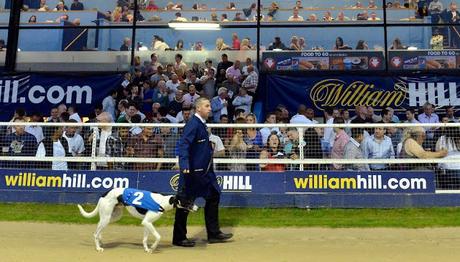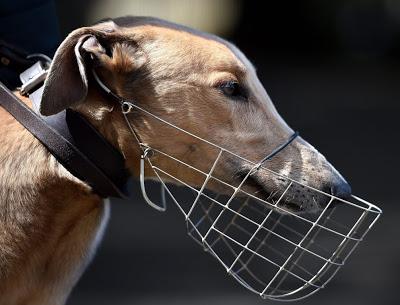 The
growing pressure from AFC Wimbledon for a bigger stadium comes as they climb
the ranks of English football, having been promoted six times in 13 seasons.The
original Wimbledon FC was founded in 1889 and played at Plough Lane from 1912
to 1991, famously winning the FA Cup final against Liverpool in 1988.Fans set
up the new club after Wimbledon FC, who had been ground-sharing for years with
Crystal Palace, were told in 2002 they would have to move 80 miles north to
Milton Keynes and rebrand as MK Dons, following a requirement to have
all-seater stadiums.
British
media reports that punters young and old are saddened as the most famous dog
racing venue in the country prepares to face its final curtain. The Wimbledon Stadium is not really in
Wimbledon. With an SW17 postcode, the last dog track in London is technically
in Tooting and, to confuse matters further, sits next door to Streatham
cemetery. The arena itself is low and aluminium-clad but while it pushes right
out on to Plough Lane, the entrance is at the back, through a series of vacant
lots, past an American diner and behind a mock Tudor building that must at some
point have been a pub but is now a wood-flooring warehouse painted rust orange.
Something
about Wimbledon Stadium feels out of place and soon it will be out of time. The
venue closes its doors forever after 89
years of greyhound, speedway and, latterly, banger racing. It is to be
demolished and replaced with housing, a retail center and a new home for AFC
Wimbledon. Perhaps as many as 2,000 people will watch the final night’s
entertainment. There will be three-course meals served in the restaurant, pints
pulled beneath the terraces and three quarters of the stadium will remain
shuttered in darkness.To say that greyhound racing is not what it was might be
stating the obvious. Crowds have fallen to around two million a year (an all-time
low) and, when Wimbledon closes, there will be only 24 tracks remaining in the
country. But it is also the case that the sport has long meant different things
to different people. There are the gamblers, there are the day trippers and
there are those for whom the dogs are a way of life.
Just
as one had seen outside the Guindy race course in Madras, there were people who
on every Saturday were buying a copy of the Racing Post and studied the form to
count “That’s 3, 4, 5 and 6,” listing out the possibilities – the gates
would open at 6.30pm, an hour before the
first race ~ and greyhounds would dash in mad race. As the races begin the young people start to
arrive. There were to be 12 races over the course of the evening; eight of them
‘open’, the highest grade of race as it admitted dogs of any category and from any breeder. For
each race the rhythm was the same. The dogs would emerge from their pits,
trotting briskly on their paws like dressage horses or en pointe ballet
dancers. They are led to the track by their handlers, all of whom wear long
white coats, like lab technicians or butchers, and are escorted to their traps.
The dogs mewl and bark and scrape at the grilles that contain them then, at the
yank of a lever, they burst forth, chasing an electrified lure around the sandy
track. The dogs are graceful, expressionless missiles. As they race their
handlers perform their own less-elegant dash; a herd of white coats heading to
the finish line where they will beckon their animal to a halt.
All
that would not happen from now on, it is getting shut down in part because the
sport is declining but just as importantly, because London land values are
continuing to rise. This Wimbledon
stadium was built in 1928 by “the Cockney millionaire” William Cearns. It is
now owned by Risk Capital Partners, a private equity firm run by the former
Channel 4 chairman Luke Johnson. Risk Capital bought the then Greyhound Racing
Association and its six dog tracks 12 years ago. Two of the six are now closed,
with Wimbledon the third. The twist on this particular redevelopment is that it
was the pledge to build a 10,000-capacity football ground that helped persuade
Merton council to push through a deal.
“There’s
very few dogs left now, to be fair,” said one who breeds dogs at his Ireland-based stud,
Hollyoak, bemoaning the loss of prize
money, claiming that many races no longer make financial sense for trainers.
Greyhound racing is not about to die. It is still the sixth most watched sport
in Britain and those remaining stadiums are in some ways stable, increasingly
owned by bookmakers who up the prize money and stream the action live into
their shops (where the real money is).
The
growing pressure from AFC Wimbledon for a bigger stadium comes as they climb
the ranks of English football, having been promoted six times in 13 seasons.The
original Wimbledon FC was founded in 1889 and played at Plough Lane from 1912
to 1991, famously winning the FA Cup final against Liverpool in 1988.Fans set
up the new club after Wimbledon FC, who had been ground-sharing for years with
Crystal Palace, were told in 2002 they would have to move 80 miles north to
Milton Keynes and rebrand as MK Dons, following a requirement to have
all-seater stadiums.
British
media reports that punters young and old are saddened as the most famous dog
racing venue in the country prepares to face its final curtain. The Wimbledon Stadium is not really in
Wimbledon. With an SW17 postcode, the last dog track in London is technically
in Tooting and, to confuse matters further, sits next door to Streatham
cemetery. The arena itself is low and aluminium-clad but while it pushes right
out on to Plough Lane, the entrance is at the back, through a series of vacant
lots, past an American diner and behind a mock Tudor building that must at some
point have been a pub but is now a wood-flooring warehouse painted rust orange.
Something
about Wimbledon Stadium feels out of place and soon it will be out of time. The
venue closes its doors forever after 89
years of greyhound, speedway and, latterly, banger racing. It is to be
demolished and replaced with housing, a retail center and a new home for AFC
Wimbledon. Perhaps as many as 2,000 people will watch the final night’s
entertainment. There will be three-course meals served in the restaurant, pints
pulled beneath the terraces and three quarters of the stadium will remain
shuttered in darkness.To say that greyhound racing is not what it was might be
stating the obvious. Crowds have fallen to around two million a year (an all-time
low) and, when Wimbledon closes, there will be only 24 tracks remaining in the
country. But it is also the case that the sport has long meant different things
to different people. There are the gamblers, there are the day trippers and
there are those for whom the dogs are a way of life.
Just
as one had seen outside the Guindy race course in Madras, there were people who
on every Saturday were buying a copy of the Racing Post and studied the form to
count “That’s 3, 4, 5 and 6,” listing out the possibilities – the gates
would open at 6.30pm, an hour before the
first race ~ and greyhounds would dash in mad race. As the races begin the young people start to
arrive. There were to be 12 races over the course of the evening; eight of them
‘open’, the highest grade of race as it admitted dogs of any category and from any breeder. For
each race the rhythm was the same. The dogs would emerge from their pits,
trotting briskly on their paws like dressage horses or en pointe ballet
dancers. They are led to the track by their handlers, all of whom wear long
white coats, like lab technicians or butchers, and are escorted to their traps.
The dogs mewl and bark and scrape at the grilles that contain them then, at the
yank of a lever, they burst forth, chasing an electrified lure around the sandy
track. The dogs are graceful, expressionless missiles. As they race their
handlers perform their own less-elegant dash; a herd of white coats heading to
the finish line where they will beckon their animal to a halt.
All
that would not happen from now on, it is getting shut down in part because the
sport is declining but just as importantly, because London land values are
continuing to rise. This Wimbledon
stadium was built in 1928 by “the Cockney millionaire” William Cearns. It is
now owned by Risk Capital Partners, a private equity firm run by the former
Channel 4 chairman Luke Johnson. Risk Capital bought the then Greyhound Racing
Association and its six dog tracks 12 years ago. Two of the six are now closed,
with Wimbledon the third. The twist on this particular redevelopment is that it
was the pledge to build a 10,000-capacity football ground that helped persuade
Merton council to push through a deal.
“There’s
very few dogs left now, to be fair,” said one who breeds dogs at his Ireland-based stud,
Hollyoak, bemoaning the loss of prize
money, claiming that many races no longer make financial sense for trainers.
Greyhound racing is not about to die. It is still the sixth most watched sport
in Britain and those remaining stadiums are in some ways stable, increasingly
owned by bookmakers who up the prize money and stream the action live into
their shops (where the real money is).
 As
the game may have a natural death, down under, a dog’s trainer approached the
vet after a race in the Hunter, saying his dog had broken its hock and needed
to be put down. Another, aNew South
Wales greyhound owner was able to put down six young, healthy dogs within three
weeks of obtaining them, according to internal records.The case, and others
like it, have prompted a renewed push by the NSW Greens for a breeding cap and
stronger penalties for vets and owners who euthanise healthy greyhounds.NSW’s
upper house last year voted in favour of releasing thousands of pages of
documents held by Greyhound Racing NSW, the body responsible for governing and
regulating the industry.The industry is still preparing for a suite of animal
welfare reforms following the dramatic backflip on the greyhound ban last year.
With
regards – S. Sampathkumar
As
the game may have a natural death, down under, a dog’s trainer approached the
vet after a race in the Hunter, saying his dog had broken its hock and needed
to be put down. Another, aNew South
Wales greyhound owner was able to put down six young, healthy dogs within three
weeks of obtaining them, according to internal records.The case, and others
like it, have prompted a renewed push by the NSW Greens for a breeding cap and
stronger penalties for vets and owners who euthanise healthy greyhounds.NSW’s
upper house last year voted in favour of releasing thousands of pages of
documents held by Greyhound Racing NSW, the body responsible for governing and
regulating the industry.The industry is still preparing for a suite of animal
welfare reforms following the dramatic backflip on the greyhound ban last year.
With
regards – S. Sampathkumar
4th Apr 2017.

